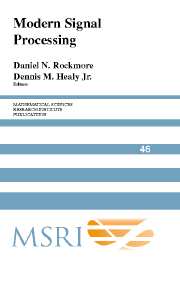Book contents
- Frontmatter
- Contents
- Introduction: A New Generation of Signal Processing
- Hyperbolic Geometry, Nehari's Theorem, Electric Circuits, and Analog Signal Processing
- Engineering Applications of the Motion-Group Fourier Transform
- Fast X-Ray and Beamlet Transforms for Three-Dimensional Data
- Fourier Analysis and Phylogenetic Trees
- Diffuse Tomography as a Source of Challenging Nonlinear Inverse Problems for a General Class of Networks
- An Invitation to Matrix-Valued Spherical Functions: Linearization of Products in the Case of Complex Projective Space P2(ℂ)
- Image Registration for MRI
- Image Compression: The Mathematics of JPEG 2000
- Integrated Sensing and Processing for Statistical Pattern Recognition
- Sampling of Functions and Sections for Compact Groups
- The Cooley-Tukey FFT and Group Theory
- Signal Processing in Optical Fibers
- The Generalized Spike Process, Sparsity, and Statistical Independence
Integrated Sensing and Processing for Statistical Pattern Recognition
Published online by Cambridge University Press: 25 June 2025
- Frontmatter
- Contents
- Introduction: A New Generation of Signal Processing
- Hyperbolic Geometry, Nehari's Theorem, Electric Circuits, and Analog Signal Processing
- Engineering Applications of the Motion-Group Fourier Transform
- Fast X-Ray and Beamlet Transforms for Three-Dimensional Data
- Fourier Analysis and Phylogenetic Trees
- Diffuse Tomography as a Source of Challenging Nonlinear Inverse Problems for a General Class of Networks
- An Invitation to Matrix-Valued Spherical Functions: Linearization of Products in the Case of Complex Projective Space P2(ℂ)
- Image Registration for MRI
- Image Compression: The Mathematics of JPEG 2000
- Integrated Sensing and Processing for Statistical Pattern Recognition
- Sampling of Functions and Sections for Compact Groups
- The Cooley-Tukey FFT and Group Theory
- Signal Processing in Optical Fibers
- The Generalized Spike Process, Sparsity, and Statistical Independence
Summary
This article presents a simple version of Integrated Sensing and Processing (ISP) for statistical pattern recognition wherein the sensor measureIllents to be taken are adaptively selected based on task-specific metries. Thus the measurement space in which the pattern recognition task is ultimately addressed integrates adaptive sensor technology with the specific task for which the sensor is employed. This end-to-end optimization of sensor/ processor/exploitation subsystems is a theme of the DARPA Defense Sciences Office Applied and Computational Mathematics Program's ISP program. We illustrate the idea with a pedagogical example and application to the HyMap hyperspectral sensor and the Tufts University “artificial nose” chemical sensor.
1. Introduction
An important activity, common to many fields of endeavor, is the act of refining high order information (detections of events, classification of objects, identification of activities, etc.) from large volumes of diverse data which is increasingly available through modern means of measurement, communication, and processing. This exploitation function winnows the available data concerning an object or situation in order to extract useful and actionable information, quite often through the application of techniques from statistical pattern recognition to the data. This may involve activities like detection, identification, and classification which are applied to the raw measured data, or possibly to partially processed information derived from it.
When new data are sought in order to obtain information about a specific situation, it is now increasingly common to have many different measurement degrees of freedom potentially available for the task.
Information
- Type
- Chapter
- Information
- Modern Signal Processing , pp. 223 - 246Publisher: Cambridge University PressPrint publication year: 2004
